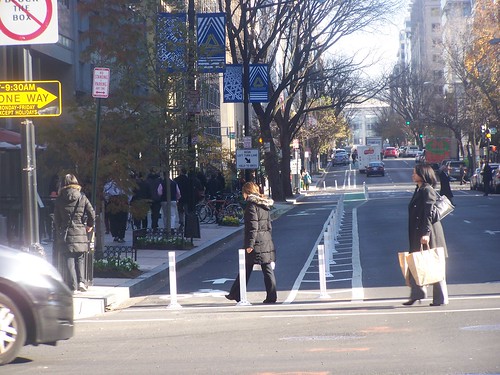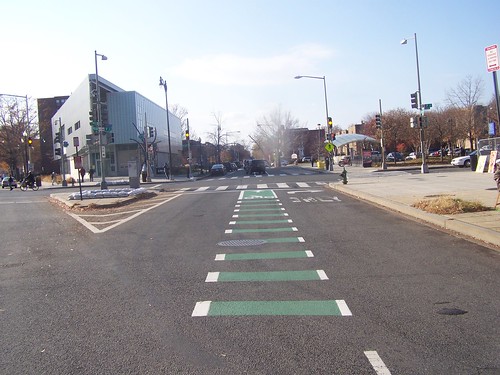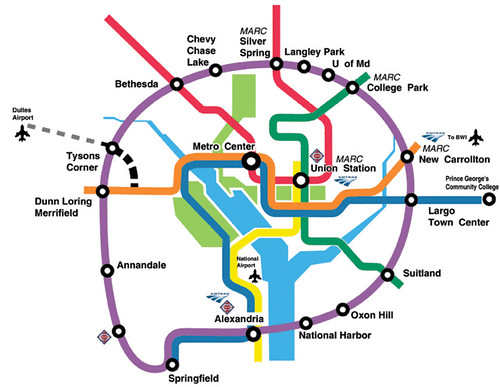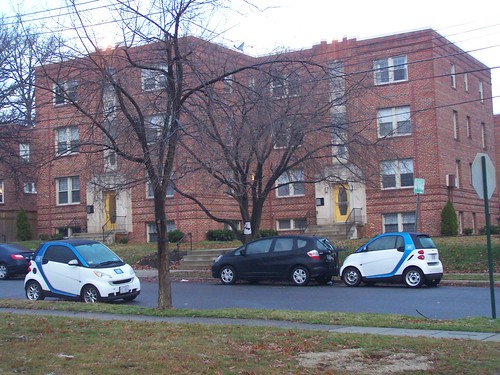2012 DC's (More than) Top 10 Transportation Stories
-----------
Also see the addendum from the next day, ""Top 10" transportation stories: continued."
-----------
So the Washington Post's Dr. Gridlock writes in "The D.C. region's transportation top 10 for 2012: Breaking through some bottlenecks," listing:
1. Opening of High Occupancy Toll Lanes in Northern Virginia. (Similar toll lanes opened in Los Angeles too. Both initiatives do encourage single occupant vehicle use.)
2. A direct freeway link between north and south DC 295.
3. Improvements at I-495 and Telegraph Road in Virginia
4. New Rush Plus system on the WMATA subway system (diverting more blue line trains to the yellow line).
5. Metro Fare Increases.
 6. The creation of the L Street NW cycletrack in DC.
6. The creation of the L Street NW cycletrack in DC. This is important too because of all the f*****g whining by motor vehicle users about taking away a parking-traffic lane.
The so-called war on drivers is less about bicyclists and transit users and more about entitled cry babies--motor vehicle operators--not wanting or being willing to share admittedly scarce roadway space--note that fewer than 150 parking spots were lost in favor of the cycletrack while there are thousands of off-street parking places located within one block on either side of L Street NW.
This is the first high quality cycle track on a regular DC street. (I don't count the Pennsylvania Avenue cycletrack which is in the middle of the street, and the pavement quality of the 15th Street cycletrack is substandard on most blocks.)
See "L Street cycle track causing frustration among drivers" from WJLA-TV, "L Street Cycle Track Draws Cheers, Boos, and Confusion: It’s a win for the cycling community, but another headache for DC drivers" from the Washingtonian Magazine and "Dear Washingtonian: You Make a Great Argument Why You Should Ride a Bike" from the JDAntos blog.
 R Street NW at 7th Street NW.
R Street NW at 7th Street NW.Note that the city continues to add bike lanes, such as around Columbus Circle/Massachusetts Avenue NE in front of Union Station, signage, continues to expand off-road shared use paths, such as the opening of a bridge on the Anacostia Riverwalk Trail earlier this year, and is in the midst of a program to add green paint to bike lanes in "conflict zones." And after advocacy by the new group The Assembly, the city clarified that it is illegal to make U turns through the median/bike lanes on Pennsylvania Avenue NW.
And my photo of the cycletrack on Pennsylvania Avenue NW made the cover of TRB News.
7. Repairs to the Dupont Circle escalators
8. Continued delays in opening up the multimodal Silver Spring transit center adjacent to the Silver Spring Metro Station (which will be one of the busiest suburban transit centers in the U.S.).
9. Beginning the construction of the extension of the Inter County Connector toll road further into Prince George's County.
10. The Apple debacle of replacing Google Maps with their own substandard program with the introduction of the IPhone5.
A counter-list is offered by the Mid-Atlantic chapter of the American Automobile Association. See the press release "Milestones And Milestones: The Best And The Worst In Transportation In Maryland, Virginia and the District of Columbia During 2012."
It's hard for me to write such an article, because I am micro-focused and admittedly don't pay equal attention to all aspects of transportation--I tend to focus on transit, biking, and walking. So I appreciate the Dr. Gridlock list as a good jumping off point. I'd add these items, without limiting the list to a specific number (except that it becomes unreasonably long).
Suggested additions to Dr. Gridlock's list:
Nationally-important transportation events
Dr. Gridlock lists Apple's Google Maps decision. As bad a decision as that was, it wouldn't rate top 10 for me, at least not over the federal transportation reauthorization bill. Plus #8 below probably would rank as well, just because of all the attention that Uber is getting across the country.
1. The new federal transportation funding bill sucks for transit, walking, and biking. It was a major miscalculation by the Democrats in 2009 to postpone the reauthorization. The 2010 election was a rout of Democrats in the House of Representatives, including people like Jim Oberstar, then the chair of the House Transportation Committee. Such a result wasn't considered when making the decision to postpone the reauthorization. The only good thing about the bill is that it is only for two years.
2. The related failure to raise the federal gasoline excise tax, which has been about 18 cents per gallon for almost 20 years. As mileage per gallon improves and as the roadway system ages, the amount of money generated by this tax comes nowhere near the amount required to maintain the system, let alone improve or expand it. And talk about imposing instead a tax per mile seems to be technologically daunting when it comes to practical implementation.
3. The failure and/or tribulations on moving high speed rail forward nationally, although it is moving forward at the state-level in California, albeit with many issues.
This past week, China opened a new HSR line. See "China Opens Longest High-Speed Rail Line" from the New York Times and this Time Magazine photo essay. China is using the creation of an HSR system as a jobs (and graft) initiative. Plus it allows for an upgrading of the railroad system, and by diverting a significant amount of passenger traffic to the HSR system from the traditional railroad lines, freight traffic, especially of freight normally delivered by truck, can be diverted to rail, with improvements to air quality.
4. Failures in many places to authorize additional transportation taxes--most transportation districts in Georgia, including Metro Atlanta did not pass such taxes and so far, not one authorization in Washington State of an additional fee on car registrations (called "car tabs") where the amount requires a public vote. (An initiative to accelerate funding of rail transit expansion in Los Angeles also failed, although a separate more limited vote on creating a streetcar tax district for a line in Downtown Los Angeles did pass.)
Image from HBA, an architecture and interior design firm in Virginia Beach.
Although regionally, voters in Virginia Beach, Virginia voted in favor of expanding the Tide light rail system from Norfolk to their city, even though the metropolitan area has been roiled by the coming of tolls to the Interstate system there to pay for new underwater tunnels, and in the face of opposition by municipal workers unions, who argue that funding light rail service displaces funds that could be available for wage and benefit increases.
5. The voting result in Clackamas County, Oregon (in Greater Portland) that now requires a pro-vote by citizens for any light rail project is a negative also. ("Smart Growth vs. Dumb Growth | Urbanism vs. Suburbanism -- politics in Clackamas County, Oregon" and "Clackamas County Oregon referendum requiring citizens vote in favor to participate in light rail projects passes")
Hopefully, this isn't an event that will lead to similar actions in other places.
 People wait in a line that wraps around a city block wait to board shuttle buses, instead of trains, into Manhattan as the city tries to recover from the after effects of Hurricane Sandy in Brooklyn. Justin Lane, European Press Photoagency.
People wait in a line that wraps around a city block wait to board shuttle buses, instead of trains, into Manhattan as the city tries to recover from the after effects of Hurricane Sandy in Brooklyn. Justin Lane, European Press Photoagency.6. The relatively quick rebound of the New York City subway system after Superstorm Sandy related flooding demonstrates that transit systems can be well-operated... now the MTA director, Ray Lhota, is considering running for Mayor of New York City.
Of course, the devasting impact of Superstorm Sandy on the transportation system in New York and New Jersey especially was an event that has to be leading to major changes in disaster planning protocols for transit systems around the country. (Buy a bike as part of your disaster kit.)
7. Local initiatives across the country to provide mobile applications for transit information. (In the DC area, Arlington County's Mobility Lab has been leading the way. See "Hack Day Resulting in Transit-Screen Excitement.")
Left: screen image from the Accessible Dispatch website.
8. Initiatives by companies like Parking Panda, Accessible Dispatch in New York City, and Uber to develop mobile phone application enabled systems for improved mobility. Relatedly, the successful campaign by Uber to offer their product in various cities while vociferously avoiding being treated as a public common carrier, subject to the same service and regulatory requirements that taxi services have to follow.
9. The 100th anniversary of the San Francisco Municipal Railway system on 12/28/2012. SF MUNI is the nation's first publicly owned transit system. See "Municipal Railway celebrates 100 years" and "City Hall must tackle Muni's problems" from the San Francisco Chronicle and the San Francisco Railway Museum website.
Note that 4 and 5 are lessons that having transportation-related votes not during the November election can be problematic. Many fewer people vote in primaries, and the people likely to favor sustainable transportation (although there were many other problems with the Georgia initiatives) are more likely to vote in the General Election.
10. The expansion of parklet programs in many cities across the country, improving quality of streetspaces and converting road and parking lanes into space for pedestrians and bicyclists. Los Angeles, Chicago, Long Beach, San Francisco, New York City...
11. Expansion of street closure--Open Streets--programs. Ciclavia in Los Angeles gets hundreds of thousands of people participating! But more and more communities are doing such programs.
Suggested additions to Dr. Gridlock's list:
2012's top local and regional transportation stories
Note: while numbered, these items are not necessarily ordered in terms of importance. Items 1 through 10 would be from the original Dr. Gridlock list. Plus I don't list pedestrian safety and pedestrian and bicycle deaths. They probably should be #1 on every annual list.
11. The almost total meltdown of the Metropolitan Washington Airports Authority in terms of self-dealing, nepotism, favored contracts, hiring former board members, etc. Ironically, in an interview I did with the Washington Business Journal in 2009, I made the point that the MWAA was well-run and the directorship was the best and "easiest" major transportation job in the region. Little did I know...
12. While media reported in the last couple weeks that "transit" use in the metropolitan area has increased over the past four years ("Public transportation use on the rise in D.C. region" from the Examiner), the real story is that WMATA's ridership has dropped in the last year--counter to national trends--in large part because of high fares and the drop in federal transit benefits. (It will be interesting to see the impact over the coming year from new leadership of the planning and real estate departments.)
13. Opposition to rail transit improvements and transit oriented development in Alexandria ("Alexandria revising Beauregard development plan," Examiner), Arlington ("Columbia Pike housing, transit questioned," Post), and the Langley Crossroads area of Maryland ("Proposed Langley transit center has tradeoff," Capital News Service) is mounting because of legitimate fears that over time, transit improvements will raise demand for residential and commercial property, displacing low income residents.
This is an interesting "development" and splinters the usual coalition of the poor and the progressive left, who normally favor transit funding and transit expansion.
14. The almost failure to extend the Silver Line into Loudoun County, the vote by the County Supervisors, the debacle over where to put a station at Dulles Airport, apoplexy over price increases for the Dulles Toll Road, the actions of the MWAA Board of Directors on these matters. ("Without the right planning "controls" you can't stop change: Loudoun County and rail service in Northern Virginia")
-----
I'd consider #11 through #14 to be important enough to merit listing on Dr. Gridlocks's top 10.
-----
15. The expansion of the Silver Line to western Fairfax and Loudoun Counties makes these counties more competitive for federal agency leases against Arlington, Montgomery, and Prince George's Counties because they can offer lower rents + subway access. New GSA leasing guidelines preference access to subway service as a decision criterion. So without the Silver Line, they can't compete for federal agencies.
16. The announcement of a master plan for the expansion of Washington's Union Station and the appointment of Beverly Swaim-Staley, former Secretary of the Maryland State Department of Transportation to be the director of the Union Station Redevelopment Corporation. This appointment means that the local powers-that-are want the expansion of Union Station to happen. Until you start to see real activity, this doesn't merit a top 10 designation, but long term, it's extremely important.
-------
Normally, I'd say this should be listed as one of the year's top 10, but, I tend to favor inclusion of events when you start to see something happen. Right now, this is all about planning and palavering and will take 5-15 years to begin to see things happen.
-------
17. Relatedly, planning for the expansion of Long Bridge across the Potomac, the possibility of expanding to four tracks south of Union Station into Virginia, the creation of a railroad station at L'Enfant Plaza, and the continued expansion of railroad passenger service throughout Virginia, including this month's opening of service to Norfolk. While Virginia refuses to get it together with regard to transportation funding--because it requires a tax increase, which the rural-dominated State Legislature won't approve--they are a national leader among states in terms of supporting rail passenger service expansion.
18. The continued advocacy by the Growth Machine in Northern Virginia* for building an I-95 western bypass, which would fuel exurban sprawl. See the report they commissioned from the GMU Center for Regional Analysis ("Connecting Transportation Investment and the Economy in Metropolitan Washington"). Counter this with the SuperNOVA Transportation planning initiative, which is multi-modal with a major focus on transportation demand management, by the State of Virginia.
* Northern Virginia Growth Machine coordinating organizations = The 2030 Group and the Northern Virginia Transportation Alliance.
19. The continued failure to fund transportation improvements in the State of Virginia, the continued outsourcing of new projects (HOT Lanes in Northern Virginia, new tunnels in Hampton Roads, etc.) to "public"-private partnerships--really for profit consortiums, continued unwillingness to allow local transportation districts to have taxing authority to fund local projects, Governor McDonnell's power play to appoint members to the WMATA Board of Directors and the Board of the Metropolitan Washington Airports Authority, unwillingness to consider increasing the Virgnia gasoline excise tax rate, which has been cents for 17.5 cents/gallon for 26 years ("Virginia State Senator Proposes New Gas Tax" from WAMU Radio).
20. Interestingly, it's a step forward that Fairfax and Montgomery County legislators are starting to work together to consider figuring out transportation improvements between the counties, especially concerning the American Legion Bridge is a step forward. ("County officials mull toll roads along American Legion Bridge" from the Gazette).
Maybe they'll even start talking--I doubt it--about extending the Purple Line westward into Virginia.

Image from the Sierra Club Sustainable Metro DC campaign.
21. Relatedly, one Montgomery County legislator suggests getting the authority to impose a county-level gasoline excise tax--I agree in theory but it won't work for one county, instead all counties should agree to impose such a tax across the entire metropolitan area.
22. The Inter County Connector toll road in Montgomery and Prince George's County rates a listing of its own. First, it's losing money and likely won't ever generate positive returns ("Study says ICC revenue won't cover costs of road," Montgomery County Sentinel). Second, many people aren't paying the toll ("ICC users rack up unpaid tolls," Post). Third, another Montgomery County legislator suggests lowering the prices of the tolls to increase use--but all it would do probably is generate the same amount of money ("ICC's tolls here to stay," Gazette).
23. BRAC-related agency moves have caused transportation havoc in Northern Virginia, Montgomery County, and Anne Arundel County. See "A Strategy for Central Maryland’s Increasing Crush of Traffic" from the Mobility Lab blog about Fort Meade. (Note that I predicted this in a blog entry I wrote in 2005, immediately after the announcement. For the most part, agencies have been moved from subway-connected locations to places with limited transit access.)
24. Continued streetcar planning debacles in DC and Arlington County. DC released an RFQ to find a third party builder-operator, and it's likely that revenue service won't start until 2014 on H Street. In the meantime, they have to figure out the issue of what to build and where to put a streetcar maintenance and yard facility. In Arlington County, considered a national best practice example of sustainable transportation excellence, there are many people, including a new member of the Arlington County Board, who do not favor going forward with plans to build a streetcar system for Columbia Pike (and other parts of the County).
More on this in a separate entry.
25. Proposals by WMATA to cut night-time service in part of Southeast Washington, DC, in response to continued vandalism ("rocking" etc.) targeting Metrobuses. After public outcry and offers of assistance from DC, WMATA has withdrawn this proposal.
26. Taxi service reform in DC. I think that it is always bad to "reform" things without "plans" and we don't have a master transportation plan in DC nor a taxi and common carrier element of such a plan. But it will require taxi operators to take credit cards and implement Taxi Magic like credit card and ad systems across the various fleets. Another element is to have the taxis all be painted the same way, to make taxis very visible and identifiable. (Meanwhile, in Arlington, the County decided not to award a taxi operator certificate to a proposal which would have provide an all-electric fleet.)
27. Expansion of the Capital Bikeshare system both in the original partner communities of DC and Arlington County, but to Alexandria in 2012, and to Montgomery County in 2013. Plus the system, at least in DC, is profitable on an operating basis. And Arlington County has produced a bike sharing master plan, which no other jurisdiction has done. (Personally, I think it's almost impossible to make bike sharing work in non-dense places, but it will be interesting to observe how it works out.)
Relatedly, the Maryland Department of Transportation's Bikeways Program provides grants to local jurisdictions for improvements in bicycle infrastructure. This relatively new program is likely an example of national best practice.
28. Continued problems with transit service reliability, resulting in large part from budget problems includes service from the metropolitan transit service, WMATA, and the separate local bus services in the cities and counties, service screw ups such as not providing enough service on special event days or for "federal holidays" like Veterans Day when many people not working for the federal government have to work, etc. ("WMATA noncommittal about changing holiday plans after riders fume" from the Washington Examiner).
29. Continued outcry against speed and traffic light cameras. In DC, a committee recommended a price drop for tickets, plus Mayor Gray promulgated an executive order to raise speed limits on certain DC freeways that had set speed limits below levels that are typically-expected for these types of roads, although the changes were not approved by DC City Council. See "D.C. Council rebuffs Vince Gray on speed limits, cameras" from the Washington Examiner.
In Baltimore, an investigation discovered that many of the tickets are issued in error. See "City speed camera 'nightmare'" and "General Assembly to scrutinize speed camera law" from the Baltimore Sun.
 30. The introduction of the one-way car sharing system, Car2Go, to DC and the speed of take up of the service. In this press release, Car2Go reports that the introduction of the service to DC has been the fastest of any of their deployments in the US or Europe. ("100 Days of car2go Success in Washington D.C: 100 New Additional Cars, for 8,500 New Members")
30. The introduction of the one-way car sharing system, Car2Go, to DC and the speed of take up of the service. In this press release, Car2Go reports that the introduction of the service to DC has been the fastest of any of their deployments in the US or Europe. ("100 Days of car2go Success in Washington D.C: 100 New Additional Cars, for 8,500 New Members")Yes I joined, and I am a member of Zipcar too. We use it for one way trips (yes, some might have otherwise been conducted via transit) where otherwise we might use a cab. E.g., coming back from the airport the other day, rather than wait in a long taxi line, we took the Metro and got off at L'Enfant Plaza because there was a car waiting for us on Maryland Avenue SW...
Because of the familiarity with car sharing in the city because of Zipcar, it makes sense that there is a large base of potential users here...also because there is still a good chance you can find a place to park. (Having just been in San Francisco, while I think it would be a great place for Car2Go in theory, the difficulty of finding a place to park once you want to end your trip makes such a service potentially problematic.)
31. The unwillingness of the Washington Nationals baseball team to pay for extension of WMATA service hours on an as-needed basis. This is a team that still doesn't think that getting a $700 million stadium for free was enough. While the city's professional hockey and basketball teams will pay for extended service hours as necessary, the baseball team continues to refuse, suggesting that the city do it. This past playoff season, the locally-based Internet company Living Social agreed to pay as a publicity stunt. See "LivingSocial to Fund Extended Metro Service Throughout Nationals Post-season" from NBC Washington. That's not a long term solution.
32. Failure to expand bus service at night to those routes where increased demand warrants it. See the July blog entry, "Washington Post article on the demand for night-time bus service." An honorable mention blog entry would be "Making bus service sexy and more equitable."
Honorable mention
33. As part of the deal to not make Eric Olson the president of the Prince George's County Council next year--probably because he is seen by the Executive Branch as not malleable enough--the new chair of the County Public Safety Committee, which has jurisdiction over traffic enforcement among other matters, will be Karen Toles, who was arrested for speeding in excess of 100 mph on the Capital Beltway ("Environmentalist Eric Olson loses bid to head Prince George's County Council," Post).
Photo by James Sterbenz.
34. The GGW entry on the guy who has figured out bus designs for the area's bus transit services, using legos. See "DC transit in lego."
Labels: bicycle sharing, bicycling, car culture and automobility, traffic engineering, traffic safety and enforcement, transportation infrastructure, transportation planning



.jpg)




2 Comments:
Great information. This works great for me. Thanks for sharing this :)
I was so anxiuos to know what my husband was always doing late outside the house so i started contacting investigators and was scamed severly until i almost gave up then i contacted this one private investigator and he delivered a good job showing evidences i needed from the apps on his phone like whatsapp,facebook,instagram and others and i went ahead to file my divorce papers with the evidences i got,He also went ahead to get me back some of my lost money i sent to those other fake investigators,every dollar i spent on these jobs was worth it.Contact him so he also help you.
mail: premiumhackservices@gmail.com
text or call +1 7078685071
Post a Comment
<< Home